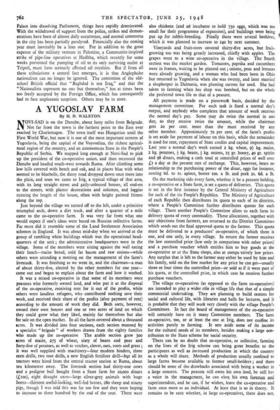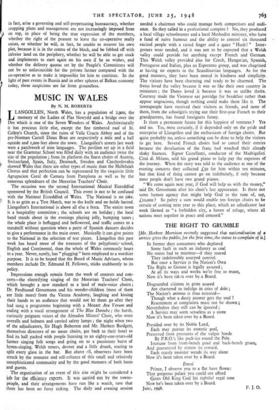A YUGOSLAV FARM
By H. D. WALSTON Just beyond the village we turned off to the left, under a primitive triumphal arch, down a dirt track, and after a quarter of a mile came to the co-operative farm. It was very far from what one would expect if one's ideas were based on Russian collective farms. Far more did it resemble some of the Land Settlement Association schemes in England. It was about mid-day when we arrived at the group of rambling white buildings which was the operational head- quarters of the unit ; the administrative headquarters were in the village. Some of the members were sitting against the wall eating their lunch—maize bread, cold fat bacon and raw onions—while others were attending a meeting on the management of the farm's livestock. It was finishing as we went in, and the chairman—a man of about thirty-five, elected by the other members for one year— came out and began to explain about the farm and how it worked.
It was a mixed co-operative in that some of its members were peasants who formerly owned land, and who put it at the disposal of the co-operative, receiving rent for it out of the profits, while others were landless refugees, who contributed nothing save their work, and received their share of the profits (after payment of rent) according to the amount of work they did. Both sorts, however, owned their own houses and one or two acres of land on which they could grow what they liked, mainly for themselves but also for sale on the open market. In all the farm covered about a thousand acres. It was divided into four sections, each section manned by a specialist " brigade " of workers drawn from the eighty families who made up the co-operative The arable section grew 300 acres of maize, 275 of wheat, sixty of beans and peas and forty-five of potatoes, as well as vetches, clover, oats, roots and grass ; it was well supplied with machinery—four modern binders, three corn drills, two root drills, a new English fertiliser drill—but all its tractors were hired from the central tractor station at Ruma, about ten kilometres away. The livestock section had thirty-one cows and a pedigree bull bought from a State farm for 20,000 dinars (Liao), eight draught oxen—large silver-grey animals with huge horns—thirteen useful-looking, well-fed horses, 28o sheep and ninety pigs, though I was told this was far too few and they were hoping to increase to three hundred by the end of the year. There were also chickens (and au incubator to hold 750 eggs, which was too small for their programme of expansion), and buildings were being put up for rabbit-breeding. Finally there were several beehives, which it was planned to increase to 240 by next summer.
Vineyards and fruit-trees covered thirty-five acres, but fruit- growing too was being greatly increased, chiefly with apples. The grapes went to a wine co-operative in the village. The fourth section was the market garden. Tomatoes, paprika and cucumbers were in frames, waiting to be planted out ; onions, peas and lettuces were already growing, and a woman who had been born in Ohio but returned to Yugoslavia when she was twenty, and later married a shopkeeper in Dalmatia, was planting carrots for seed. She had taken to farming when her shop was bombed, but on the whole she preferred town life to that of a peasant.
All payment is made on a piecework basis, decided by the management committee. For each task is fixed a normal day's output, and anybody who completes that amount of work receives the normal day's pay. Some may do twice the normal in one day, so they receive twice the amount, while the chairman gets 20 per cent. more than the most received by any other member. Approximately 70 per cent. of the farm's profits is set aside for payment of labour on this basis, while the remainder is used for rent, repayment of State credits and capital improvement. Last year a normal day's work earned 2 kg. wheat, 9-4 kg. maize, 2 kg. potatoes, 3 kg. beans, kg. onions, 25 gr. honey, 4o gr. spirits and 98 dinars, making a cash total at controlled prices of well over ki a day at the present rate of exchange. This, however, bears no relationship to the purchasing power of the dinar, eggs for instance, costing 6d. to Is. apiece, butter ros. a lb. and pork 2s. 6d. a lb.
On the marketing side every farm, whether it be a peasant holding, a co-operative or a State farm, is set a quota of deliveries. This quota is set in the first instance by the Central Ministry of Agriculture for each of the six People's Republics. The Ministry of Agriculture of each Republic then distributes its quota to each of its districts, where a People's Committee further distributes quotas for each village. There another People's Committee allots to each farm its delivery quota of every commodity. These allocations, together with any objections from farmers, are returned to the District Committee which sends out the final approved quota to the farmer. This quota must be delivered to a producers' co-operative, of which there is one, and one only, in every village. In return the farmer receives the low controlled price (low only in comparison with other prices) and a purchase voucher which entitles him to buy goods at the co-operative or at the State shops, also at compa-atively low prices. Any surplus that is left to the farmer may either be used by him and his family, sold on the free market for any price he can get—usually three or four times the controlled price—or sold as if it were part of his quota, at the controlled price, in which case he receives further purchase vouchers.
The village co-operatives (as opposed to the farm co-operatives) are intended to play a wider role in village life that that of a simple commercial undertaking. They are planning to build centres for social and cultural life, with libraries and halls for lectures, and it is probable that they will work very closely with the village People's Committees. In fact the board of management of the co-operative will certainly have on it many Committee members. The farm co-operative, too, or at least the one at Irig, does not confine its activities purely to farming. It sets aside some of its income for the cultural needs of its members, besides making a large con- tribution to the State scheme for social security.
There can be no doubt that co-operative, or collective, farming on the lines of the Irig scheme can bring great benefits to the participants as well as increased production in which the country as a whole will share. Methods of production usually confined to large farms become available to former small-holders ; and there should be none of the drawbacks associated with being a worker in a large concern. The peasant still owns his own land, he still has a voice in the management, he can elect his own foreman and superintendent, and he can, if he wishes, leave the co-operative and farm once more as an individual. At least that is so in theory. It remains to be seen whether, in large co-operatives, there does not,
in fact, arise a governing and self-perpetuating bureaucracy, whether cropping plans and management are not increasingly imposed from on top, in place of being the true expression of the members, whether the right of the peasant to leave the co-operative really exists, or whether he will, in fact, be unable to recover his own plot, because it is in the centre of the block, and be fobbed off with inferior land on the periphery, whether he will be able to get stock and implements to start again on his own if he so wishes, and whether the delivery quotas set by the People's Committees will not be so unfavourable for the private farmer compared with the co-operative as to make it impossible for him to continue. In the light of past events in Russia and in other spheres of Balkan economy today, these suspicions are far from groundless.































 Previous page
Previous page